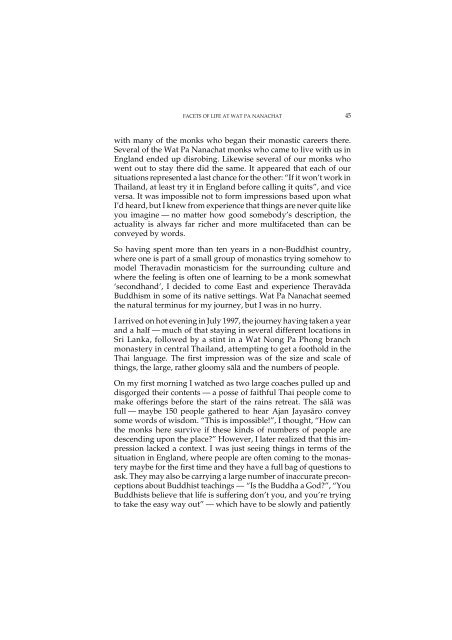Forest Path - Amaravati Buddhist Monastery
Forest Path - Amaravati Buddhist Monastery
Forest Path - Amaravati Buddhist Monastery
Create successful ePaper yourself
Turn your PDF publications into a flip-book with our unique Google optimized e-Paper software.
facets of life at wat pa nanachat 45<br />
with many of the monks who began their monastic careers there.<br />
Several of the Wat Pa Nanachat monks who came to live with us in<br />
England ended up disrobing. Likewise several of our monks who<br />
went out to stay there did the same. It appeared that each of our<br />
situations represented a last chance for the other: “If it won’t work in<br />
Thailand, at least try it in England before calling it quits”, and vice<br />
versa. It was impossible not to form impressions based upon what<br />
I’d heard, but I knew from experience that things are never quite like<br />
you imagine — no matter how good somebody’s description, the<br />
actuality is always far richer and more multifaceted than can be<br />
conveyed by words.<br />
So having spent more than ten years in a non-<strong>Buddhist</strong> country,<br />
where one is part of a small group of monastics trying somehow to<br />
model Theravadin monasticism for the surrounding culture and<br />
where the feeling is often one of learning to be a monk somewhat<br />
‘secondhand’, I decided to come East and experience Theravàda<br />
Buddhism in some of its native settings. Wat Pa Nanachat seemed<br />
the natural terminus for my journey, but I was in no hurry.<br />
I arrived on hot evening in July 1997, the journey having taken a year<br />
and a half — much of that staying in several different locations in<br />
Sri Lanka, followed by a stint in a Wat Nong Pa Phong branch<br />
monastery in central Thailand, attempting to get a foothold in the<br />
Thai language. The first impression was of the size and scale of<br />
things, the large, rather gloomy sàlà and the numbers of people.<br />
On my first morning I watched as two large coaches pulled up and<br />
disgorged their contents — a posse of faithful Thai people come to<br />
make offerings before the start of the rains retreat. The sàlà was<br />
full — maybe 150 people gathered to hear Ajan Jayasàro convey<br />
some words of wisdom. “This is impossible!”, I thought, “How can<br />
the monks here survive if these kinds of numbers of people are<br />
descending upon the place?” However, I later realized that this impression<br />
lacked a context. I was just seeing things in terms of the<br />
situation in England, where people are often coming to the monastery<br />
maybe for the first time and they have a full bag of questions to<br />
ask. They may also be carrying a large number of inaccurate preconceptions<br />
about <strong>Buddhist</strong> teachings — “Is the Buddha a God?”, “You<br />
<strong>Buddhist</strong>s believe that life is suffering don’t you, and you’re trying<br />
to take the easy way out” — which have to be slowly and patiently

















